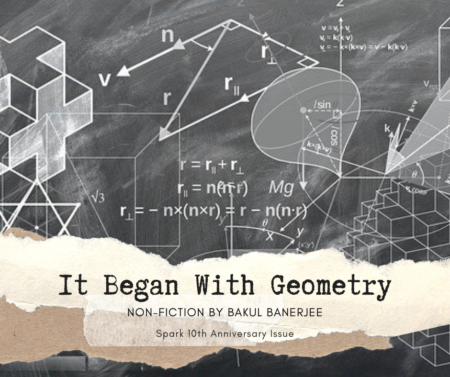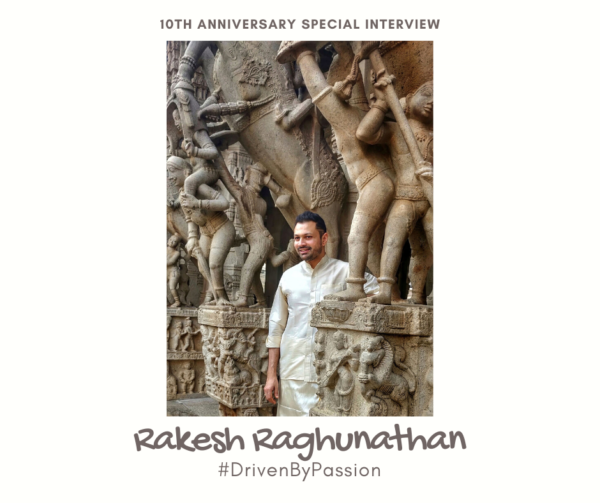by Bakul Banerjee
Bakul Banerjee writes an essay sharing her personal experience of how her love and passion for Geometry eventually led to a career in Science, something that she continues to be passionate about.
On the second day of my sixth-grade, my mother and my little brother came to pick me up after school, instead of the silent Nepali woman who usually walked with me from school to home. At the end of the previous school year, I had taken home a report card with a ridiculous failing grade in sewing. Although I was mortified, it did not prevent my promotion, perhaps because I aced almost all other subjects. My last sewing assignment was to embroider the sleeve of a blouse duplicating a classic Kashmiri design. However, my handiwork was quite bad.
‘You will be taking Geometry this year instead of sewing,’ my mother said, as we crossed the bridge over a rapidly flowing stream. It was not a subject offered to a sixth-grader, yet she managed to make that possible, perhaps using the excuse of my very poor eyesight. Indeed, I was the only girl in the entire school sporting thick eyeglasses.
‘Look at those wild, white swirls in the river,’ my brother exclaimed, leaning against the railings of the bridge. I felt a shiver, perhaps because of the cold mountain air, and pulled my navy blue coat closer. The news of switching to Geometry was not exactly comforting because I didn’t even know the word geometry. However, when my father sat down with me with the brand new Geometry book, I felt a strange excitement. I fell in love with Geometry first, then with other branches of Mathematics later. Unlike sewing, a geometrical proof had to be either right or wrong. I understood Geometry from the beginning. Later, I enjoyed the challenges of Algebra and Calculus in high school and decided to major in Mathematics in college.
My college years at the Presidency College in Kolkata were embroiled in communist-minded student protests. However, amidst all that, one of my best memories from those years is the thrill I experienced when I learned in the Projective Geometry class that two parallel lines might meet at infinity. Many years later, when I saw Mona Lisa in Louvre, Paris, I realised that the vista vanishing behind the enigmatic woman was a masterful illustration of the concept by Leonardo Da Vinci. The Infinite Series class was taught by Dr. Sanat Bose, the Principal of the famed college. I often pondered how he could forget the turmoil around him including death threats and immerse himself in teaching a small class about the Fibonacci sequence. Growing up, I believed that mothers and professors had eyes in the back of their heads, and that they could monitor our foibles even when their backs were turned. Dr. Bose, though, did not have those extra eyes. Male students, with their hormones raging, did stupid things behind his back, perhaps to impress a few females in the class. The professor, however, seemed to be mesmerised by the subject he was teaching. Almost half a century later, I still think about his passion for infinite series and sequences when I come across a stalk of fern in a flower bouquet or a small spiral cactus displayed as a table decoration.
As a college student, I befriended the college librarian, convincing him to let me borrow the precious reference copy of Whitehead and Russell’s Principia Mathematica, and carrying it home for 15 days. At the age of sixteen, I could only follow the first 50 or so pages before I had to return it. Even my father, quite a mathematician in his own right, narrowed his eyes when I showed it to him! In fact, feeling all nostalgic, I bought a copy of the book at a used book sale in Chicago for a mere twenty dollars some years ago.
Feeding on my love affair with Mathematics, I joined the Johns Hopkins University in Baltimore, Maryland, to complete my doctoral work in Computational Geophysics. Working with the large amount of geosynchronous satellite orbital data gathered by NASA Goddard Space Flight Center, I developed predictive models of density variations of the earth’s interior. This work contributed to a better understanding of the emerging theory of plate tectonics. Like many women, particularly immigrant women of my times, my career path meandered to accommodate job prospects for my husband. I followed him wherever he found a job. Working in the field of my specialization was not an option. Fortunately, I stumbled upon jobs in systems and software engineering at some of the most intriguing scientific and engineering facilities in the world. Looking back, most of these positions were related to the construction of new technical facilities managed by the US Department of Energy, giving me opportunities to be an insider of such intricate endeavours from their inceptions. Many of these projects, like Advanced Photon Source at Argonne National Laboratory or Tevatron Accelerator project at Fermilab, both near Chicago, were of huge physical dimensions with complex geometries and advanced electronics. During my work at the Uranium Enrichment Plant at Portsmouth, Ohio, I would stand on somewhat wobbly, gridded platforms more than seventy feet high, looking down at very tall cylindrical centrifuges.
Post-retirement, I continue with my long-term volunteering work for the Institute for Electrical and Electronics Engineers. Fortunately, because of my association with this professional organization, I get to learn about current research in science and engineering from the comfort of my home. Of late, I have been following advances in brain research, particularly those related to brain diseases. Recently, I attended a six-hour-long webinar as I hovered over the stove and the Instapot, prepping for a full course Thanksgiving dinner. I am, of course, delighted that my passion for science continues to burn fiercely, and looking back, I can confidently say that it all began with that time in my sixth-grade when I made that life-changing switch from sewing to Geometry.
An award-winning author and poet Bakul Banerjee published her second collection of previously published poems, titled Bathymetry: Poems, in 2017. Her chapbook, titled Synchronicity: Poems, was published in 2010. For the past twenty years, her poems and stories appeared in several literary magazines and anthologies throughout the U.S. and India. She has been featured at several poetry readings and presented multiple poetry workshops. Bakul received a Ph.D. degree from The Johns Hopkins University.







Loved the silent Nepali escort and the wobbly gridded platform. I remember well your soaring trajectory in the US. keep the flag flying!